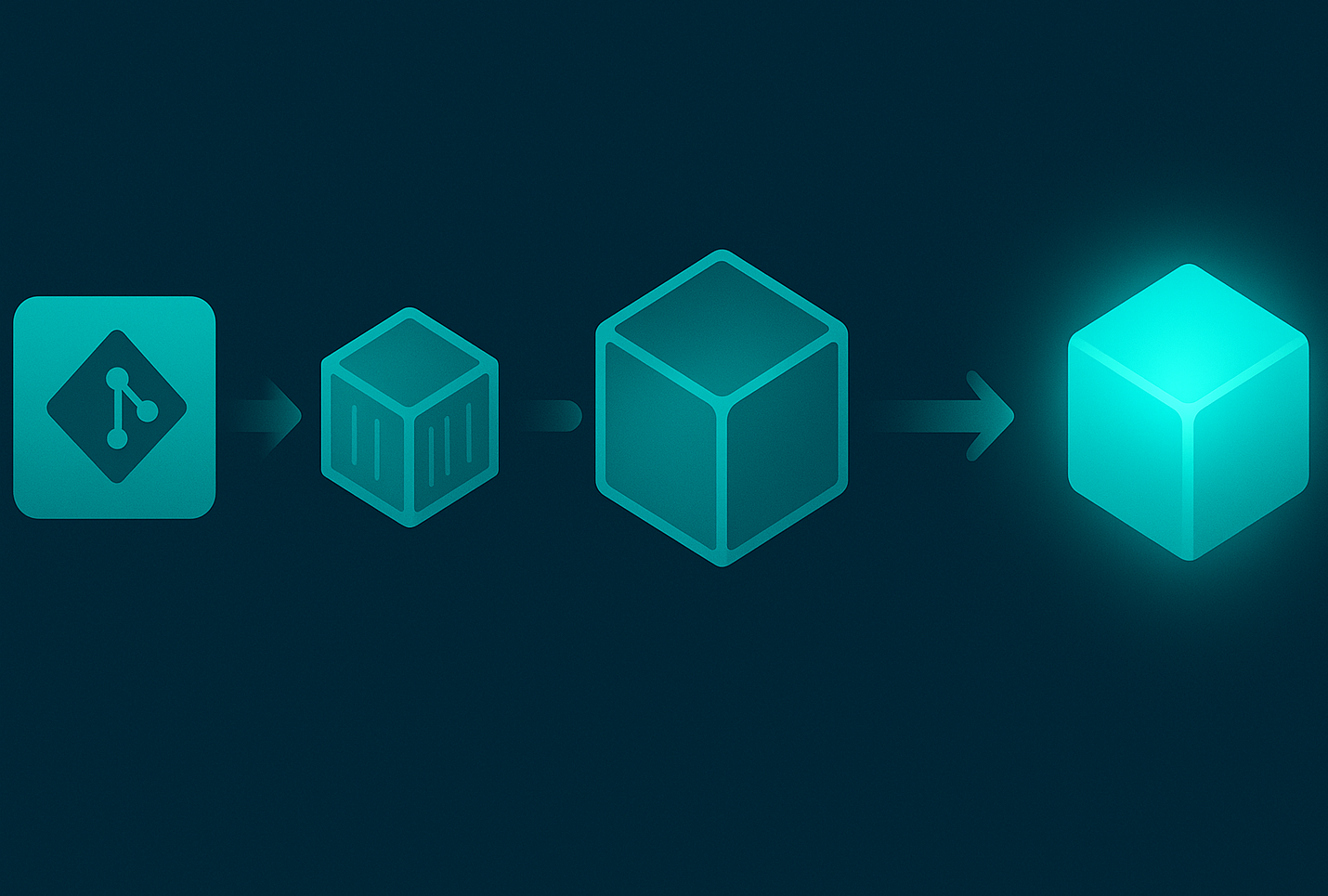
Modern web development demands both exceptional developer experience and bulletproof production deployments. SvelteKit delivers on the first promise with its elegant reactive framework and blazing-fast performance. Convox completes the picture by making production deployments as smooth as the development experience. Let's explore how to deploy SvelteKit applications on Convox and why this combination creates a powerful platform for modern web applications.

If you haven't tried SvelteKit yet, you're missing out on one of the most developer-friendly frameworks in the JavaScript ecosystem. Unlike other frameworks that ship a runtime to the browser, Svelte compiles your code at build time into vanilla JavaScript. This means smaller bundle sizes, faster initial loads, and better runtime performance.
SvelteKit takes this foundation and adds everything you need for production applications:
The framework's reactive syntax is refreshingly simple. No virtual DOM, no hooks to memorize - just write JavaScript that updates when your data changes. It's the kind of developer experience that makes you wonder why we made things so complicated in the first place.
While SvelteKit simplifies frontend development, deploying modern applications still involves wrestling with Dockerfiles, Kubernetes manifests, load balancers, SSL certificates, and cloud provider configurations. This is where Convox shines.
Convox provides a developer-focused platform that handles the infrastructure complexity while giving you the control you need. Whether you're deploying to Convox Cloud for a fully-managed experience or to your own Convox Rack on AWS, GCP, Azure, or Digital Ocean, you get the same powerful deployment experience.
Let's walk through deploying a SvelteKit application on Convox. You'll be surprised how straightforward it is.

First, ensure your SvelteKit app is using the Node adapter for server-side rendering:
npm install @sveltejs/adapter-nodeUpdate your svelte.config.js:
import adapter from '@sveltejs/adapter-node';
import { vitePreprocess } from '@sveltejs/vite-plugin-svelte';
const config = {
kit: {
adapter: adapter(),
},
preprocess: vitePreprocess(),
};
export default config;Create a simple Dockerfile in your project root:
FROM node:22-alpine
WORKDIR /app
COPY package.json package-lock.json* ./
RUN npm install
COPY . .
RUN npm run build
EXPOSE 3000
CMD ["node", "build"]This Dockerfile is production-ready yet remarkably simple. No multi-stage builds needed (though Convox supports them), no complex configurations - just build and run.
Create a convox.yml file to tell Convox how to run your app:
services:
web:
build: .
port: 3000
environment:
- NODE_ENV=production
scale:
count: 2
cpu: 256
memory: 512This configuration gives you:
For Convox Cloud (our fully-managed platform):
# Create your app
convox cloud apps create my-sveltekit-app -i production
# Deploy it
convox cloud deploy -a my-sveltekit-app -i productionFor self-hosted Convox Rack:
# Create your app
convox apps create my-sveltekit-app
# Deploy it
convox deploy -a my-sveltekit-appThat's it! Your SvelteKit application is now running in production with enterprise-grade infrastructure.
When you deploy SvelteKit on Convox, you immediately benefit from:
Every app gets HTTPS automatically via Let's Encrypt. No certificate management, no renewal headaches - it just works.
Deploy new versions with zero downtime. Convox automatically rolls out changes, verifies health checks, and rolls back if something goes wrong.
Stream logs, monitor resource usage, and set up alerts:
# View real-time logs
convox logs -a my-sveltekit-app
# Check process status
convox ps -a my-sveltekit-app
# Monitor resource usage
convox scale -a my-sveltekit-appNeed more power? Scale horizontally or vertically with a single command:
# Add more instances
convox scale web --count 5 -a my-sveltekit-app
# Increase resources
convox scale web --cpu 512 --memory 1024 -a my-sveltekit-appAdd databases and other resources with simple configuration:
resources:
database:
type: postgres
options:
storage: 10
version: 13
services:
web:
build: .
port: 3000
resources:
- databaseConvox automatically injects the DATABASE_URL environment variable into your app.
SvelteKit distinguishes between private and public environment variables. Convox makes managing these simple:
# Set private variables (server-only)
convox env set API_KEY=secret-key -a my-sveltekit-app
# Set public variables (available to client)
convox env set PUBLIC_API_URL=https://api.example.com -a my-sveltekit-appConfigure your app to scale automatically based on CPU or memory usage:
services:
web:
build: .
port: 3000
scale:
count: 2-10
cpu: 256
memory: 512
targets:
cpu: 70
memory: 80Your app now scales between 2 and 10 instances based on actual load - perfect for handling traffic spikes.
Need to process tasks asynchronously? Add a worker service:
services:
web:
build: .
port: 3000
worker:
build: .
command: node worker.js
scale:
count: 1Testing changes before production? Create a preview environment in seconds:
convox apps create my-sveltekit-app-preview
convox deploy -a my-sveltekit-app-previewEach developer can have their own preview environment with isolated resources.
SvelteKit and Convox together enable powerful performance optimizations:
Configure cache headers in your SvelteKit app, and Convox's load balancers respect them:
// In your +page.server.js
export async function load({ setHeaders }) {
setHeaders({
'cache-control': 'public, max-age=3600'
});
// Your data fetching logic
}Convox automatically monitors your app's health. Customize the endpoint in your SvelteKit app:
// src/routes/health/+server.js
export function GET() {
return new Response('OK', { status: 200 });
}Then configure in convox.yml:
services:
web:
build: .
port: 3000
health:
path: /health
interval: 10
timeout: 3One of Convox's strengths is maintaining parity between development and production:
# Run your app locally with production-like environment
convox start
# Test with local databases
convox resources proxy database -a my-sveltekit-appYour local environment uses the same Docker configuration as production, eliminating "works on my machine" issues.
SvelteKit and Convox share a philosophy: powerful capabilities shouldn't require complexity. SvelteKit gives you a modern, performant framework without the typical JavaScript fatigue. Convox gives you enterprise infrastructure without the DevOps overhead.
Together, they let you focus on what matters: building great applications for your users.

Ready to deploy your SvelteKit app on Convox? Here are your next steps:
Deploying SvelteKit applications doesn't have to be complex. With Convox Cloud, you get enterprise-grade infrastructure in minutes, not weeks. The combination of Svelte's compiled efficiency, SvelteKit's full-stack capabilities, and Convox's production-ready defaults means you can focus on what matters—building exceptional user experiences.
The convox-examples/svelte repository demonstrates that production readiness doesn't require complexity. Automatic SSL, health checks, rolling deployments, and auto-scaling—it's all there, ready to use. SvelteKit brings joy back to frontend development, and Convox ensures that joy extends all the way to production.
Ready to simplify your SvelteKit deployments? Sign up for Convox Cloud today and deploy your first application in minutes. Check out our documentation for more advanced features, or reach out to cloud-support@convox.com if you need help.
Happy deploying!
Ready to deploy more applications on Convox? Explore our example repositories for other popular frameworks including Node.js, Rails, Django, Next.js, and PHP. For teams looking to automate workflows, check out our n8n deployment guide. See all examples at docs.convox.com/example-apps.
